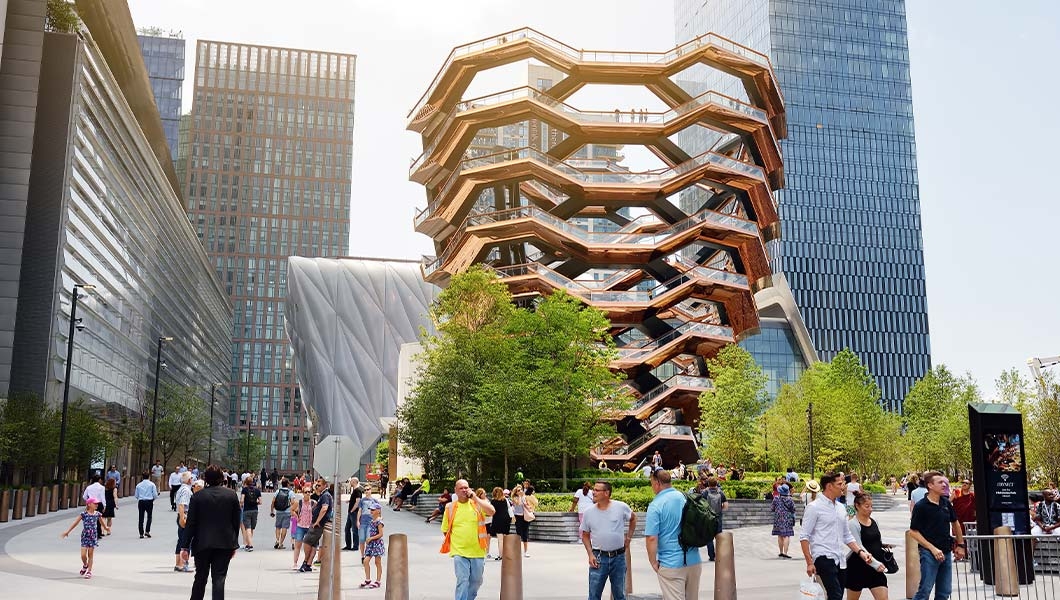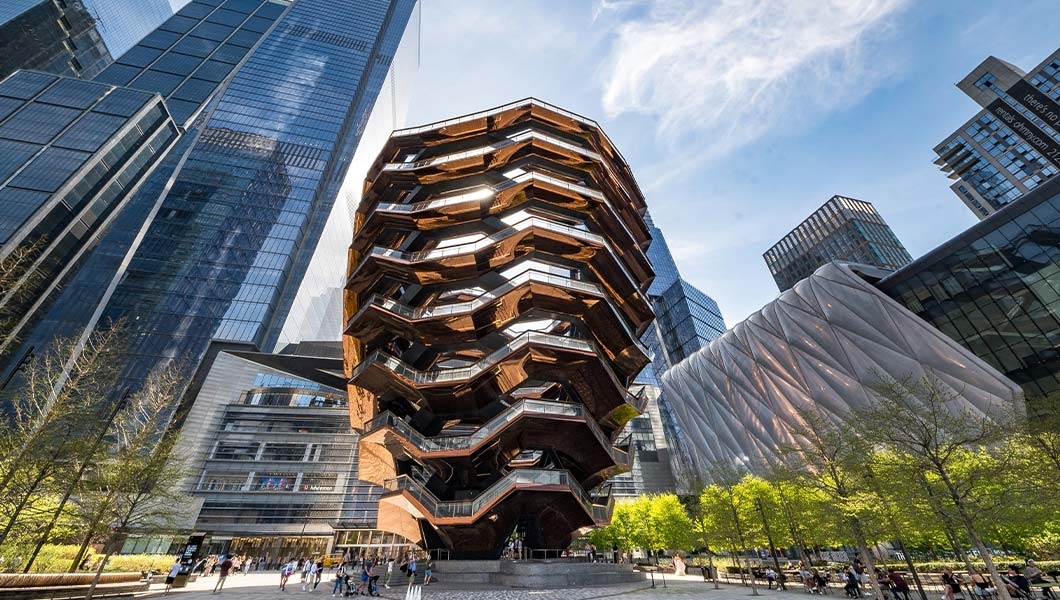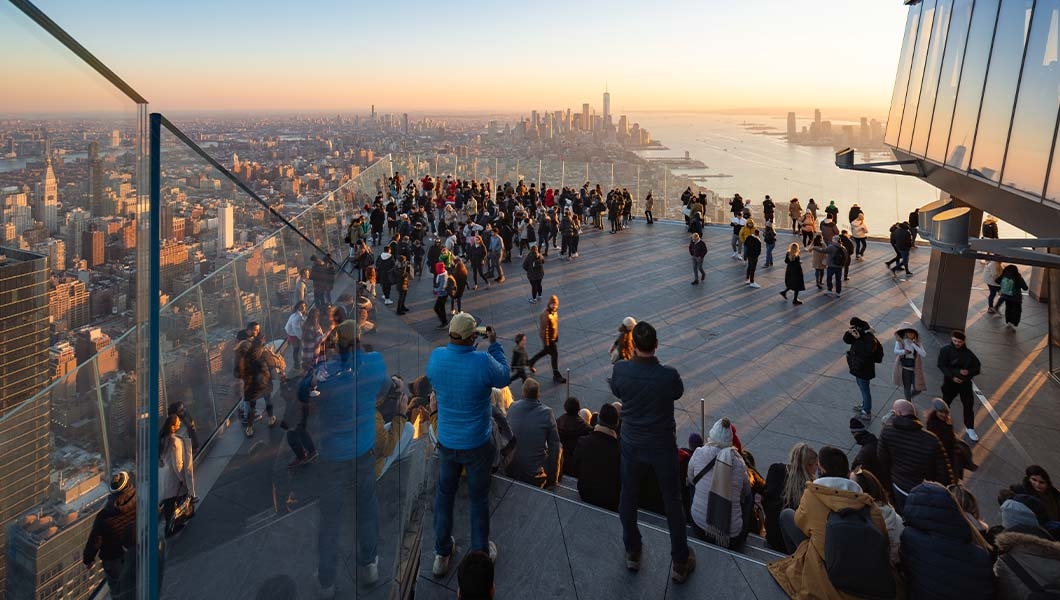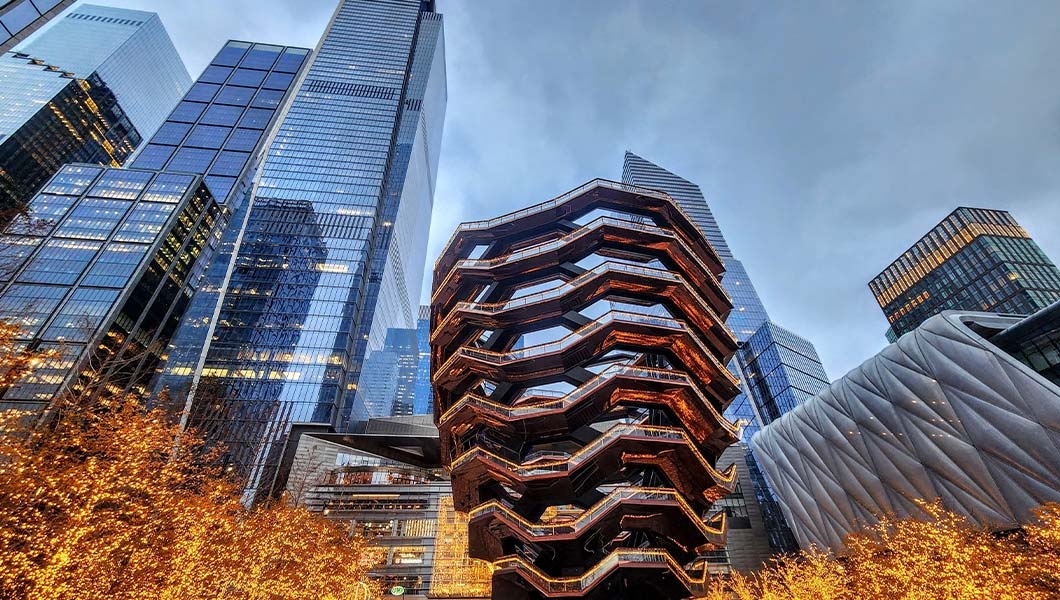My Bookings
Please Enter Your Booking Code To Find Your Booked Tour!
Hudson Yards












Overview
Explore this amazing attraction and discover what makes it a must-visit. Stay tuned for more details!
Opening Hours
- Hudson Yards is a mixed-use neighborhood, and its opening hours vary depending on the specific venue, shop, or attraction within the development. As a public space, the outdoor areas—including the public square and gardens—are generally open daily from 6:00 AM to 1:00 AM, allowing visitors to enjoy the open-air walkways, green spaces, and views of the Vessel and surrounding architecture.
- The Shops & Restaurants at Hudson Yards, located at 20 Hudson Yards, typically operate under the following hours:
- Monday to Saturday:
- 10:00 AM – 8:00 PM
- Sunday:
- 11:00 AM – 7:00 PM
- Individual store and restaurant hours may vary, especially for fine dining establishments, which may remain open later into the evening. It's recommended to check with specific retailers or restaurants in advance for the most accurate hours.
- Edge, the outdoor observation deck at 30 Hudson Yards, is open:
- Daily:
- 9:00 AM – 10:00 PM (last elevator up at 9:10 PM)
- Overall, Hudson Yards remains an accessible and vibrant destination throughout the day, offering flexible hours for leisure, dining, and cultural experiences.
Top Tips
Looks like there are no tips. Be the first one to add a tip to help people enjoy!
Anchored by the iconic towers 10 and 30 Hudson Yards, linked by the Shops and Restaurants at 20 Hudson Yards, the development features a carefully curated blend of Class A office space, luxury residences, cultural venues, and high-end retail. Major tenants like Warner Bros. Discovery, L’Oréal, BlackRock, and KKR underscore the area’s significance as a new business hub.
At the heart of the neighborhood lies 14 acres of public green space, highlighted by Thomas Heatherwick’s striking Vessel structure and The Shed, a versatile arts center. Hudson Yards is also directly connected to the extended No. 7 subway line, enhancing its accessibility.
Beyond aesthetics and utility, Hudson Yards is a model of sustainable development. It’s Manhattan’s first LEED Gold Neighborhood, incorporating on-site power generation, stormwater recycling, and energy-efficient systems. With over 18 million square feet of mixed-use space, a 200-room Equinox hotel, and thousands of residences—including affordable housing—Hudson Yards stands as a testament to modern urban innovation.
Top Tips
Much of the public space, including Vessel and Edge, is outdoors. Check the weather forecast and dress accordingly, especially during colder months or rainy days. Comfortable footwear is also a must, as you’ll be doing a lot of walking.
From fine dining to casual bites, Hudson Yards offers a wide range of restaurants. Popular spots can fill up fast, so booking a reservation—especially for dinner—is highly recommended.
Parking is limited and traffic can be heavy. The easiest way to reach Hudson Yards is by taking the 7 subway line to 34th Street–Hudson Yards station, which drops you right at the heart of the neighborhood.
If you’re planning to visit Vessel or Edge, it’s a good idea to book your Hudson Yards tickets online in advance, especially during weekends and peak hours.
How to Get There
Hudson Yards is easily accessible by multiple modes of transportation and is well-connected to the rest of New York City. Located on Manhattan’s West Side, the development stretches from 30th to 34th Street between 10th and 12th Avenues, with the main entrance at 10th Avenue and 33rd Street.
By Subway:
The most convenient way to reach Hudson Yards is via the 7 subway line. Take the train to 34th Street–Hudson Yards station, which delivers you directly to the eastern edge of the development. This modern station features escalators and elevators, making it accessible for all visitors.
By Bus:
Several MTA bus routes stop nearby, including the M34-SBS, M12, and M11, all of which serve the surrounding avenues and connect to major crosstown and uptown/downtown lines.
By Train:
If you're arriving from outside the city, Penn Station is just a 10-minute walk away. It serves Amtrak, Long Island Rail Road (LIRR), and NJ Transit lines, making Hudson Yards easily reachable from New Jersey, Long Island, and beyond.
By Foot or Bike:
Hudson Yards is pedestrian- and bike-friendly, with seamless connections to the High Line and Hudson River Park. Citi Bike stations are located nearby for easy bike-sharing access.
By Car:
While driving is possible, parking in the area is limited and can be expensive. Several public parking garages are available on nearby streets, but using public transit is strongly encouraged to avoid traffic congestion.
Best Time to Visit
The best time to visit Hudson Yards depends on what you’re hoping to experience—but generally, weekday mornings or early afternoons offer the most relaxed atmosphere with fewer crowds. This is especially ideal if you're planning to visit Edge, explore the shops, or enjoy a peaceful stroll through the public square and gardens.
Spring (April to June) and fall (September to November) are the most comfortable seasons weather-wise. During these months, temperatures are mild, and the outdoor spaces—including the High Line and Vessel’s surrounding plaza—are at their most inviting. The greenery and seasonal blooms in Hudson Yards' 5-acre public gardens are particularly vibrant in spring.
Summer brings longer daylight hours and a livelier energy, especially in the evenings. While the area can get crowded with tourists, it’s a great time to catch outdoor events, performances at The Shed, and sunset views from Edge. Just be prepared for warmer temperatures and bring sun protection.
Winter is quieter and festive, with holiday lights, seasonal decor, and indoor attractions like The Shops & Restaurants offering a cozy escape from the cold. While some outdoor experiences like Vessel and the plaza may be less accessible due to weather, it’s still a good time for shopping and indoor dining.
For the best lighting and views, aim to visit Edge or the public square during golden hour—roughly an hour before sunset. The west-facing views over the Hudson River are breathtaking and perfect for photography.
Highlights
The defining highlight of Hudson Yards is its ability to blend cutting-edge architecture, cultural innovation, and urban green space into a single, vibrant destination. At the heart of this dynamic neighborhood is Vessel, a striking 16-story honeycomb-like structure designed by Thomas Heatherwick. This interactive art installation and public landmark offers visitors a unique perspective of the city with its interconnected staircases and panoramic views.
Another crown jewel is The Edge Hudson Yards, the highest outdoor sky deck in the Western Hemisphere. Located on the 100th floor of 30 Hudson Yards, Edge juts out 80 feet from the building’s side and features a glass floor, giving brave visitors a thrilling view of the city far below and sweeping vistas of the Hudson River and Manhattan skyline.
The shops at Hudson Yards serve as the neighborhood’s commercial core, offering a luxury retail experience with over 100 stores and a wide array of dining options, from casual eateries to world-class restaurants. Food lovers often head straight to Mercado Little Spain, a Spanish food hall curated by Chef José Andrés, which brings the flavors of Spain to the West Side.
Culturally, The Shed sets Hudson Yards apart. This innovative arts center features a movable shell that allows the venue to host concerts, exhibitions, and performances in a flexible, modern space that adapts to the needs of each event.
Surrounding all of this is 14 acres of beautifully landscaped public space, with groves, gardens, fountains, and seating areas that make Hudson Yards more than just a business or retail hub—it’s a community space. The neighborhood’s seamless integration with the High Line and Hudson River Park ensures it remains connected to the broader rhythm of New York City life.
Features
Hudson Yards is more than just a collection of buildings—it’s a fully integrated, next-generation neighborhood designed for living, working, shopping, dining, and cultural engagement. Spanning 28 acres, it blends iconic architecture with cutting-edge infrastructure, world-class amenities, and thoughtfully designed public spaces.
One of its most notable features is its architectural innovation. The development includes towering landmarks like 10 Hudson Yards, 30 Hudson Yards, and 50 Hudson Yards, each offering premium office space and panoramic city views. These skyscrapers are designed by leading global architecture firms such as Kohn Pedersen Fox and Foster + Partners.
Hudson Yards also features residential living at its finest, with luxury towers like 15 Hudson Yards and 35 Hudson Yards offering upscale condominiums, exclusive amenities, and direct access to cultural attractions like The Shed and The Shops.
The neighborhood is anchored by 14 acres of open space, including tree-lined walkways, landscaped gardens, and relaxing public plazas. At its center stands Vessel, a striking climbable art installation, and nearby, The Shed hosts concerts, exhibitions, and performances year-round.
Edge, perched on the 100th floor of 30 Hudson Yards, is the tallest outdoor sky deck in the Western Hemisphere and provides unmatched 360-degree views of New York City and beyond.
Retail and dining are also central features. The Shops & Restaurants at Hudson Yards span over 1 million square feet, with everything from high-end fashion brands to global cuisine, including favorites like Mercado Little Spain, Milos, and Shake Shack.
Hudson Yards is also a leader in sustainability and smart technology. It’s Manhattan’s first LEED Gold Neighborhood Development and features on-site power generation, stormwater reuse systems, smart infrastructure, and energy-efficient design throughout.
Altogether, Hudson Yards is a blueprint for the future of urban living—ambitious, interconnected, and human-centered.
History and Fun Facts
The story of Hudson Yards is one of bold ambition, decades of planning, and groundbreaking innovation. What is now a thriving neighborhood was once a massive, underutilized rail yard on Manhattan’s Far West Side. For much of the 20th century, the site served as a storage facility for Long Island Rail Road (LIRR) trains and remained largely inaccessible to the public.
Initial proposals to develop the site date back to the 1950s, with visions ranging from housing to a towering “Freedom Tower” that never materialized. In the early 2000s, the City of New York and the Metropolitan Transportation Authority (MTA) partnered with developers to unlock the area’s potential by building a platform over the active rail yard—an engineering feat involving hundreds of caissons drilled between tracks to support the new structures above.
Construction of Hudson Yards officially began in 2012, and the first phase opened to the public in 2019. The development now includes over 18 million square feet of mixed-use space, a cultural center, the Edge observation deck, and a luxury Equinox hotel.
Fun Facts:
Largest Private Development:
Hudson Yards is the largest private real estate project in U.S. history, with a projected total cost of over $25 billion.
High Line Integration:
The development connects directly to the High Line, a beloved elevated park that runs through Chelsea and offers stunning city views.
LEED Gold Neighborhood:
Hudson Yards is the first neighborhood in Manhattan to earn LEED Gold certification for sustainability.
Edge Observation Deck:
At 1,131 feet, Edge is the highest outdoor sky deck in the Western Hemisphere, with a glass floor and angled glass walls.
Engineering Marvel:
The platform supporting Hudson Yards is built over 30 active train tracks and includes a cooling system and stormwater recycling infrastructure beneath the public square.
Quick Links
Book your Tour
Get in Touch
Toll Free
1-888-961-6584
Local
1-289-271-9767
© 2025 See Sight Tours. All Rights Reserved.
1-888-961-6584

